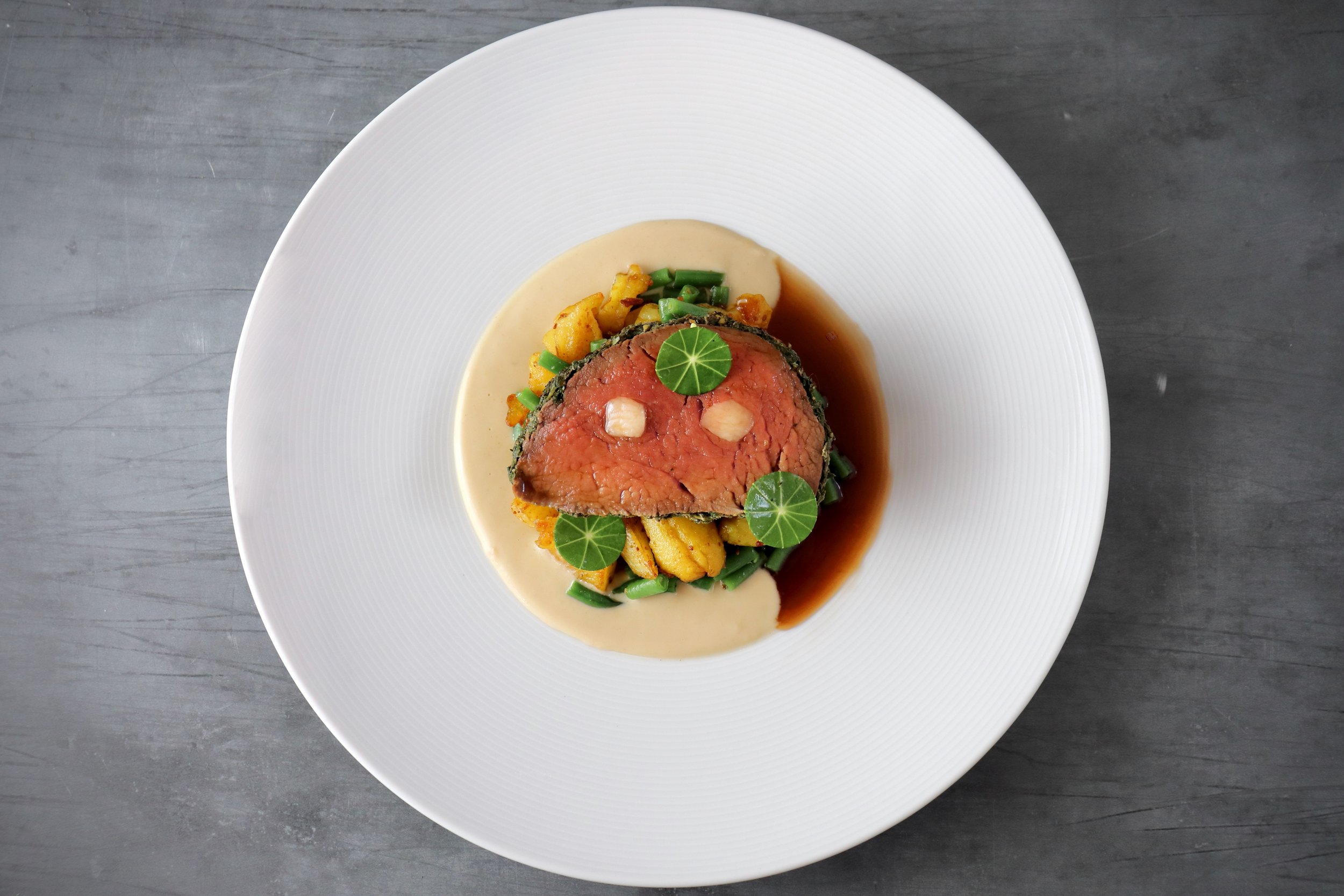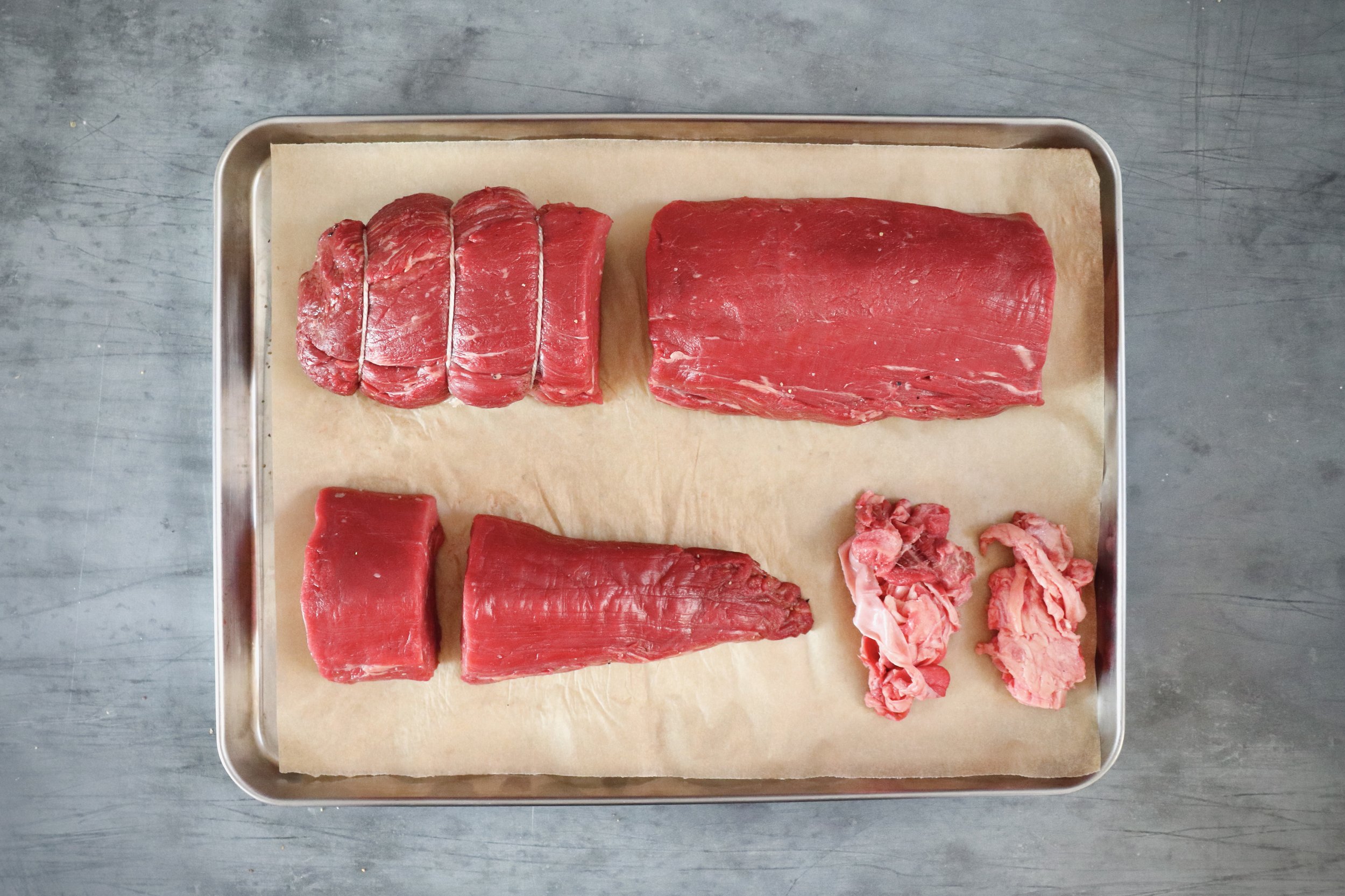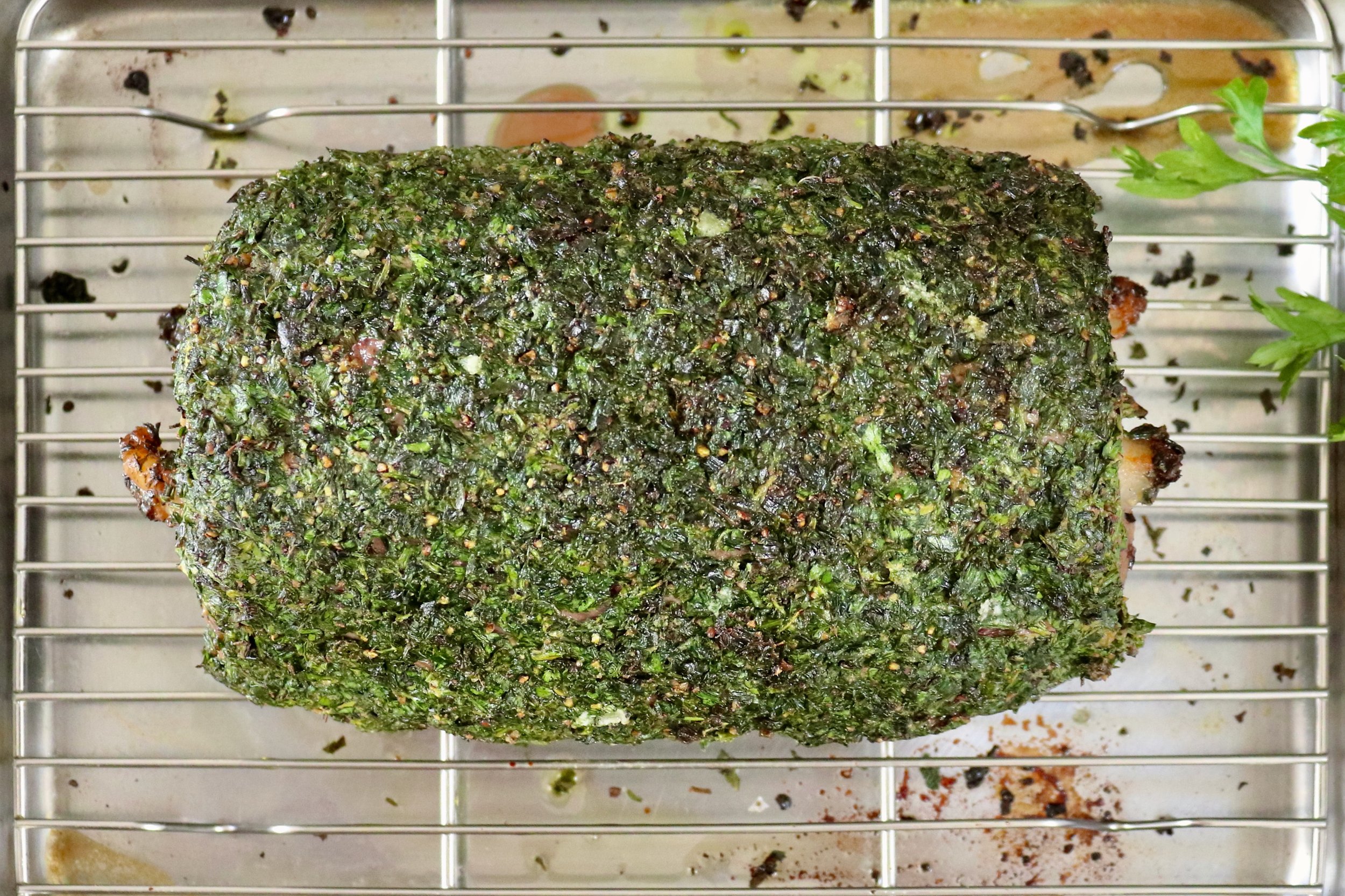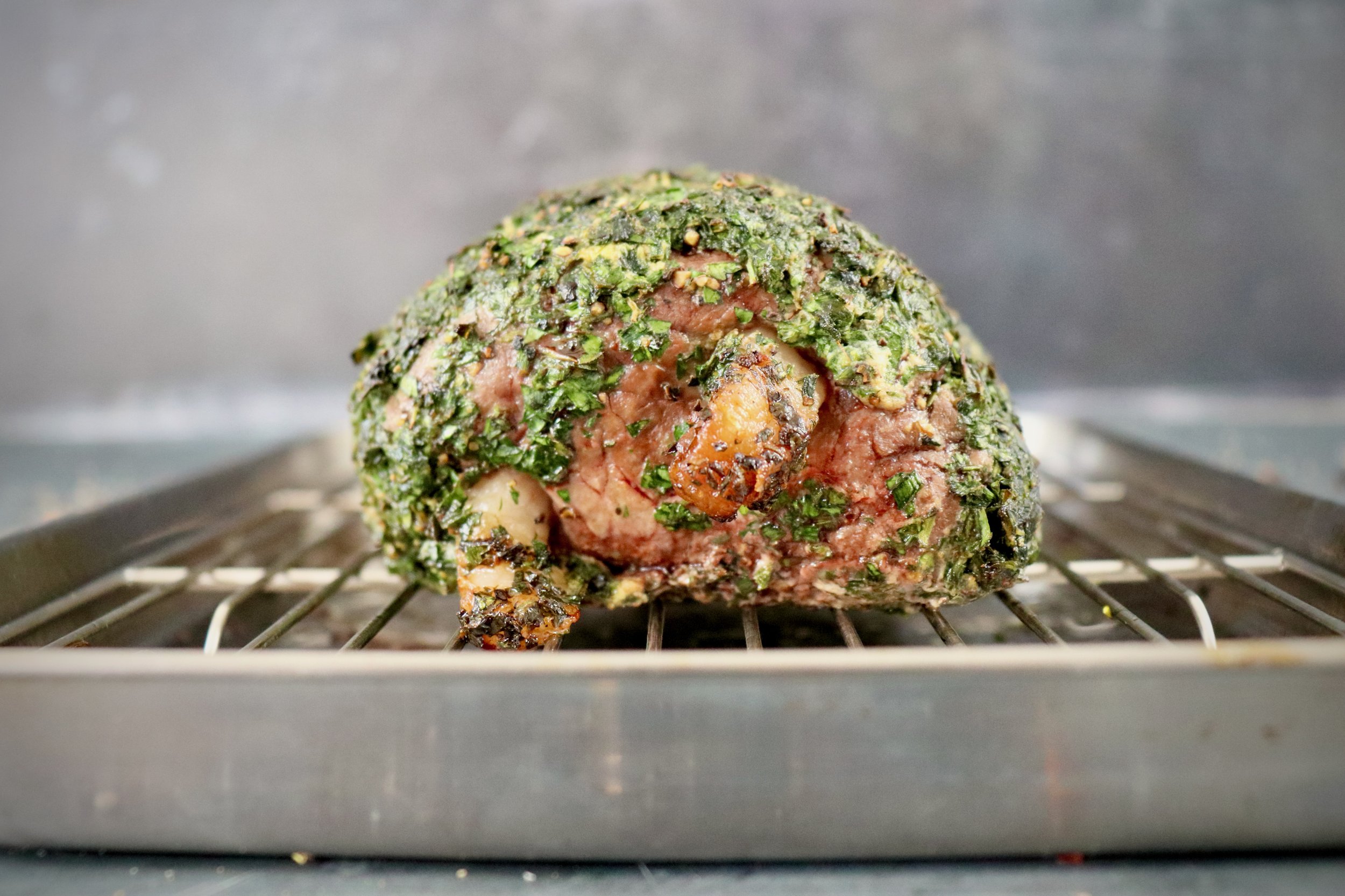Royal fillet of beef
Royal fillet of beef, creamy Viennese horseradish sauce and red wine jus, with crushed new potatoes and snappy French beans
Taking fillet of beef to the next level. Luxurious middle or centre cut fillet threaded with lardo to keep it succulent as it cooks, rolled in fresh herbs, and roasted whole. Such decadent beef deserves more than one sauce. There’s a lip-smacking red wine jus plus a saucy twist on a classic pairing brought by a creamy Viennese horseradish sauce made with beef stock and breadcrumbs. Seasonal crushed new potatoes, crisped in nut-brown butter and glazed in sherry vinegar, provide a tangy crunch while snappy french beans deliver bursts of green freshness. It may be a recipe fit for royalty but why should they have all the fun?
Ingredients
Feeds 4
Black Label Argentinian fillet, centre cut weighing approx. 800g
100g Lardo, approx. 1cm thick (high) and 2cm longer than the length of the centre cut fillet
Leaves from 1.5 bunches parsley
Leaves from 1 bunch thyme
1 bunch chives
1tbs cracked black pepper
1tbs sea salt
2tbs Dijon mustard
1 small egg white
1tbs olive oil
RED WINE JUS
Beef trimmings
1 banana shallot, finely sliced
1 bouquet garni; roll and tie 1 sprig thyme, 2 parsley stalks, 1 bay leaf, 1 celery baton in a small sheet of leek
750ml beef stock; I use TRUEfoods
500ml red wine
50ml madeira
HORSERADISH SAUCE
125g stale white bread, cubed
600ml beef stock
125ml double cream
4tbs horseradish, freshly grated (add more if you want hotter)
NEW POTATOES
500g new potatoes, washed
100g unsalted butter
30g sherry vinegar
FRENCH BEANS
300g french beans
10g unsalted butter
Method
FILLET PREPARATION
1. Freeze the lardo. When it’s hard, cut 2 “pencils” approx. 1cm square and 2cm longer than the length of the centre cut fillet. Return the lardo “pencils” to the freezer.
2. Trim the fillet, removing any fat and silverskin. Reserve both separately.
Fillet of beef with the chain removed
Trimmed fillet of beef with the silver skin and excess fat removed
3. Slice the fillet into constituent cuts separating the chateaubriand, the centre cut, and the tail. We’re only going to use the centre cut. We want a nice barrel with a consistent diameter along its length for even cooking.
Fillet of beef broken down into chateaubriand, centre cut, tournedos and tail
4. Facing one end of the centre cut, push a long skewer into the meat off-centre and to the left. Push until the skewer emerges at the other end. Keep the skewer straight and true. Give it a wiggle to widen the hole. Using a larding needle, thread one lardo “pencil” into the hole so that it overhangs the fillet at each end by about 1cm. If you don’t have a larding needle, the frozen lardo should be solid enough to push through if the hole is big enough. Use a rubber glove to hold the lardo and prevent the heat of your hand melting it. Make a second hole off-centre and to the right, and thread the second “pencil”. Tightly wrap the larded fillet in cling film, tie the ends, and leave in the fridge for a couple of hours to set up.
Larded fillet of beef
Larded fillet of beef wrapped in cling film to set up
5. Finely chop the herbs and mix with the salt and pepper. On a board, spread the herbs evenly into a rectangle wide and long enough to roll the fillet through.
6. Pat the fillet dry with kitchen paper. Whisk the egg white until just stiff then whisk in the Dijon mustard. Brush over the fillet.
7. Firmly roll the fillet through the herbs.
Larded fillet of beef rolled in parsley, thyme and chives
8. Leave in the fridge for a couple of hours to dry and set.
RED WINE JUS
1. Preheat the oven to 180C.
2. In a wide oven-safe pan, melt the fat removed from the fillet. Remove the solids from the pan.
3. Cut the silverskin and any trimmed meat into smaller pieces. Begin to brown these trimmings in the melted beef fat then roast in the oven for 10-15 minutes. Be careful not to burn.
4. Drain the pan through a fine sieve, reserving the caramelised trimmings. Degrease the pan by patting any fat with kitchen paper.
5. With the pan over a low heat, add the sliced shallot and a lid. The shallot will cause steam lifting the crusty flavoursome bits stuck to the bottom of the pan. Remove the lid and increase the temperature to colour the shallot to golden brown.
6. Add the beef trimmings back to the pan and deglaze with madeira.
7. When the madeira has all but evaporated, add the red wine and bring to a simmer. Reduce the liquid content by half. Give the bottom of the pan a good scrape then transfer the contents to a narrower, deeper saucepan.
8. Add the stock and bouquet garni. Genty simmer for 45-50 minutes, skimming all the time.
9. Pass through damp muslin cloth. (If the jus is oily, chill then remove the solidified fat. Reheat and pass again.)
10. Add the jus to a clean pan. Simmer and reduce. You want the jus to coat the back of a spoon. Season to taste.
HORSERADISH SAUCE
1. Reserve 100ml of the beef stock in the fridge.
2. In a saucepan off the heat, soak the bread in the remaining stock until absorbed.
3. Add the cream and bring to a gentle boil, stirring constantly to break down the bread.
4. Stir through the grated horseradish and remove from the heat. Cover with cling film and infuse for 2 hours at room temperature.
5. Blend until silky smooth and pass through a fine sieve into a clean saucepan. Press a piece of cling film over the surface of the sauce to remove any air. Reserve until needed.
FRENCH BEANS
1. Bring a pan of salted water to the boil. Meanwhile, trim the stalks from the beans.
2. Blanch the beans for 3 to 5 minutes depending on the thickness of the bean. You want them to be soft but retain some crunch; you’ll taste the difference when they’re cooked.
3. Refresh the beans in iced water.
4. Cut the beans into 2cm batons and reserve in the fridge until required.
NEW POTATOES
1. Place the potatoes in a saucepan with salted cold water. Gradually bring to a gentle simmer and cook until tender.
2. Sieve and leave the cooked potatoes to air dry for a few minutes.
3. Peel the potatoes while they’re still warm. Coarsely crush with a fork or your thumb.
4. In a heavy-bottomed pan, melt the butter slowly until it turns brown and smells nutty. Do not burn. Pass the butter through a sheet of kitchen roll reserving the clear fat.
5. Wipe the same pan clean. Return the fat to the pan and bring back to temperature over a medium heat. Add the crushed potatoes and cook until golden and crumbling.
6. Add the sherry vinegar and continue to cook until reduced to a glaze. Season taste.
7. Keep warm until ready to serve.
FILLET COOK
1. Preheat the oven to 220C.
2. Remove the fillet from the fridge an hour before cooking.
3. Heat olive oil in a thick-bottomed frying pan over a medium-high heat. Seal the fillet all over, about a minute per side. Take note! Avoid moving the fillet around unnecessarily. Lift it, don’t drag it. If some of the herby coating comes off you can stick it back on once the fillet is completely seared and before it goes into the oven.
4. Transfer to the oven and roast for approx. 8 minutes. Baste then carefully turn the fillet over and roast for 8 minutes more. It’ll probably be rare at this point. I like it medium-rare, removing it from the oven when the core temperature reaches 48C. Another 4 minutes, say, with another turn and baste.
5. Carefully transfer the fillet to a wire rack over a tray. Rest in a warm place for 10-15 minutes. For medium-rare the core temperature after resting should be around 54-56C.
Royal fillet of beef seared, roasted and now resting
Royal fillet of beef resting for 10-15 minutes
SERVE
1. Warm the plates.
2. Warm the horseradish sauce. It shouldn’t be too thick, just thick enough to coat the back of a spoon. It’s not a traditional British horseradish sauce. Add reserved beef stock to reach the desired consistency. Season to taste.
3. Warm the red wine jus.
4. Add the chopped beans to the potatoes and stir through to coat with the butter. Gently warm to serving temperature.
5. Slice the fillet. While the slices rest for 30 seconds, brush their faces with a dab of the red wine jus.
Carved royal fillet of beef showing a medium-rare cuisson
6. On each plate, place potatoes and beans in the centre. Spoon horseradish sauce around two thirds of the potatoes and red wine jus around the remaining third. Place a slice of beef on top of the potatoes. Garnish with shrubbery if so inclined; I used peppery nasturtium leaves.
Royal fillet of beef with a creamy Viennese horseradish sauce and lip-smacking red wine jus
Royal fillet of beef with crushed new potatoes, crisped in brown butter and glazed in sherry vinegar
Royal fillet of beef encrusted in parsley, thyme and chives












